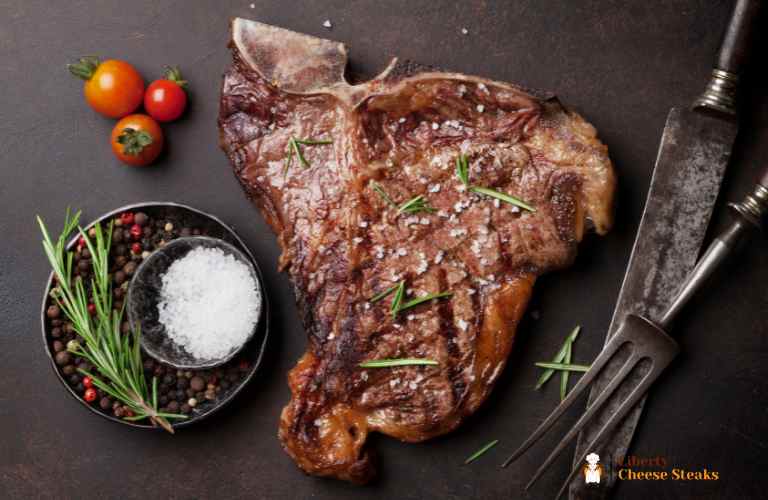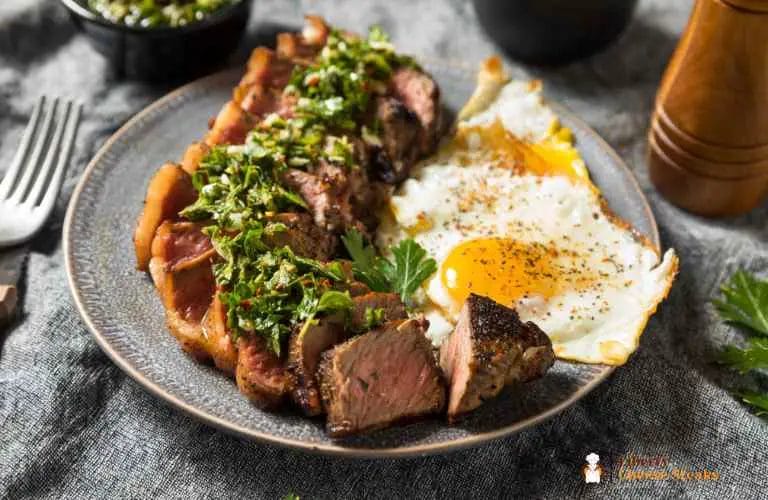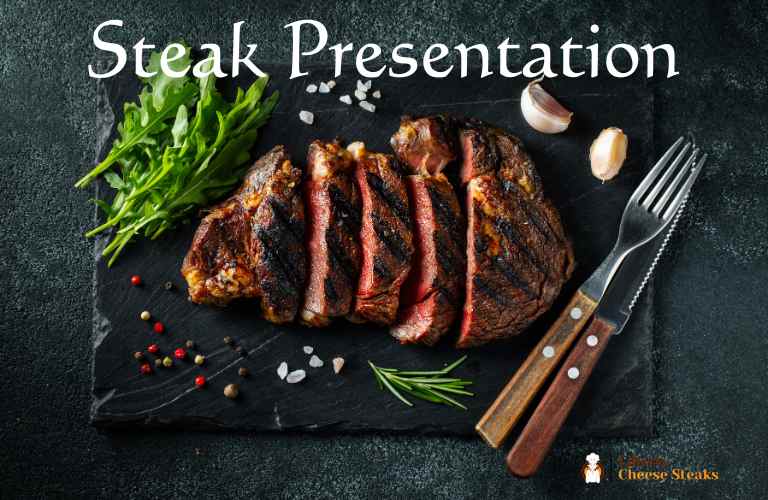Introduction When it comes to culinary delights, presentation plays a crucial role in captivating our senses and enhancing the overall dining experience.
The way a dish looks can be just as important as how it tastes, and this holds especially true for the beloved steak.
In this comprehensive guide, we will delve into the world of steak presentation and plating, exploring the concepts, techniques, and tips to help you create visually stunning and appetizing steak dishes.
Understanding Steak Presentation
Choosing the Right Cut of Steak
The first step in creating a visually appealing steak dish is selecting the right cut of meat. Different cuts offer varying textures, flavors, and marbling patterns, each suited for specific cooking methods.
Whether it’s a tender filet mignon, a flavorful ribeye, or a juicy strip steak, consider the characteristics of the cut and choose one that aligns with your desired outcome.
Considerations for Cooking Methods
Different cooking methods, such as grilling, pan-searing, or broiling, can greatly impact the final appearance of the steak.

Grilling imparts tantalizing grill marks and a smoky flavor, while pan-searing creates a delicious crust. Understand the nuances of each method and select the one that complements your plating vision.
Seasoning and Marination Techniques
Seasoning is vital in bringing out the flavors of the steak. Whether you prefer a simple salt and pepper rub or a more elaborate blend of spices, ensure that the seasoning is evenly distributed and adheres to the meat’s surface.
Marinating the steak in herbs, oils, and acids can also infuse additional flavors and tenderize the meat. Experiment with different combinations to find the perfect balance for your desired taste.
Components of a Well-Plated Steak
Main Protein:
The Star of the Dish The steak itself takes center stage on the plate, and it should be cooked to perfection. Understanding the desired level of doneness, such as rare, medium-rare, medium, or well-done, is crucial in achieving the ideal texture and juiciness.

Utilize a meat thermometer to ensure accurate cooking times and let the steak rest after cooking to allow the juices to redistribute, resulting in a tender and succulent piece of meat.
Accompaniments:
Enhancing Flavors and Textures To complement the steak, thoughtful selection of accompaniments is essential.
Consider incorporating rich and flavorful sauces or gravies that harmonize with the meat’s taste profile. Additionally, vibrant vegetable sides, such as roasted asparagus or buttery sautéed mushrooms, can add both visual appeal and a delightful textural contrast.
Starch options, such as creamy mashed potatoes or fragrant rice pilaf, can round out the dish and provide a satisfying balance.
Garnishes for Added Visual Interest
Garnishes serve as the finishing touch, elevating the presentation of the steak. Fresh herbs like parsley, chives, or thyme can add a pop of color and a touch of freshness to the plate.
Edible flowers, microgreens, or finely sliced vegetables can also be used to create visually pleasing patterns or accents.
Remember, the garnish should not overpower the main dish but rather enhance its appearance.
Plating Techniques for Steak
Choosing the Right Plate
The selection of the plate is crucial in creating an aesthetically pleasing presentation.
Consider the size and shape of the plate, ensuring it complements the size of the steak and allows for the arrangement of accompaniments without overcrowding.
Additionally, think about the color and material of the plate, as these elements can either enhance or detract from the overall presentation.
Placement and Arrangement
Placing the Steak as the Focal Point:
Position the cooked steak slightly off-center on the plate, allowing it to be the focal point of the dish. This draws the eye and showcases the main protein.
Arranging Accompaniments for Balance and Visual Appeal:
Strategically arrange the vegetable sides, starches, and sauces around the steak, creating a balanced composition. Consider the colors, shapes, and textures of each element to ensure an appealing visual contrast and harmony.
Using Negative Space for Aesthetic Effect:
Embrace the concept of negative space by leaving empty areas on the plate. This not only provides breathing room for the dish but also highlights the individual components.
Creative Plating Ideas
Stack or Layering Techniques:
Experiment with stacking or layering different components to add height and visual interest. For example, place a potato puree base, followed by the steak, and top it with caramelized onions for an elegant and striking presentation.
Drizzling Sauces and Garnishing:
Use squeeze bottles or small ladles to drizzle sauces or dressings strategically on the plate. This not only adds flavor but also creates artistic patterns. Garnish with fresh herbs or edible flowers to enhance the visual appeal.
Artistic Patterns or Arrangements:
Create eye-catching arrangements by arranging the accompaniments in artistic patterns, such as arcs, spirals, or geometric shapes. This adds a touch of creativity and showcases your attention to detail.
Tools and Presentation Tips
Essential Tools for Steak Presentation
Tongs and Spatulas:
Use sturdy tongs or spatulas when handling the steak to prevent damage or loss of juices. This ensures the steak retains its visual appeal and juiciness.
Squeeze Bottles for Sauces and Dressings:
Utilize squeeze bottles to have better control over the distribution and placement of sauces and dressings on the plate. This allows for precise drizzling or artistic designs.
Plating Rings and Molds:
Plating rings or molds can be used to shape the accompaniments, such as mashed potatoes or rice, into uniform and appealing shapes. These tools provide a professional touch to your plating.
Attention to Detail
Wiping Plate Rims for a Clean Presentation:
Before serving, carefully wipe any smudges or drips from the plate rims. This attention to detail ensures a clean and polished presentation.
Adding Finishing Touches Just Before Serving:
Place the final garnishes and sauces on the plate just before serving to maintain their freshness and vibrant appearance. This enhances the overall visual appeal of the dish.
Capturing the Perfect Photo
Lighting Considerations
Good lighting is essential for capturing enticing food photographs. Utilize natural light whenever possible, positioning the dish near a window or shooting outdoors.
If artificial lighting is necessary, use soft, diffused lighting to avoid harsh shadows and reflections.
Composition and Angles
Experiment with different angles to capture the steak dish in its best light. Consider shooting from a top-down perspective to showcase the overall plating arrangement.
Alternatively, try a lower angle to emphasize the height and texture of stacked or layered components.
Post-Processing Tips for Stunning Food Photography
During post-processing, enhance the colors, contrasts, and sharpness of the image. Adjust white balance to ensure accurate representation of the steak’s hues.
However, strive for a natural look that remains faithful to the dish’s actual appearance.
Serving and Enjoying the Steak
Temperature Considerations
It is crucial to serve the steak at the appropriate temperature to maintain its flavor and texture. Keep the plate warm to prevent the steak from cooling too quickly during the plating and serving process.
Educating Diners on Steak Cuts and Cooking
Preferences Take the opportunity to educate diners on different steak cuts, cooking methods, and levels of doneness.
Provide descriptions or menu notes that guide their choices and help them appreciate the thought and care put into the dish.
Encouraging Guests to Appreciate the Presentation
Encourage guests to take a moment to appreciate the artistry and effort put into the presentation.
Suggest that they engage their senses by observing the arrangement, inhaling the enticing aromas, and savoring the flavors that unfold on their palate.
Conclusion
Steak presentation and plating is an art form that can transform a delicious meal into a memorable dining experience.
y carefully selecting cuts, utilizing creative plating techniques, and paying attention to every detail, you can elevate the visual appeal of your steak dishes.
Remember to experiment, have fun, and let your creativity shine as you develop your own unique plating style. With these tips and techniques in mind, you’ll be well on your way to wowing your guests with visually stunning steak presentations that truly delight the senses.
Frequently Asked Questions
What are some recommended plating styles for steak dishes?
There are various plating styles you can explore for steak dishes. Some popular options include the classic style, where the steak is placed in the center with accompaniments arranged neatly around it, or the modern style, which focuses on artistic arrangements and creative use of negative space.
Experiment with different styles to find what best suits your aesthetic preferences and the overall theme of the dish.
How can I ensure that my steak remains hot while I focus on plating?
To keep your steak hot while plating, you can preheat the plates before plating. Place the plates in a warm oven or soak them in hot water for a few minutes.
Additionally, you can tent the cooked steak with aluminum foil while you arrange the other components on the plate. This helps to retain heat until the moment of serving.
Are there any plating techniques for enhancing the texture of the dish?
Yes, you can utilize plating techniques to enhance the textural experience of the dish. For instance, you can create height and texture by layering mashed potatoes or grains underneath the steak.
You can also experiment with contrasting textures by incorporating crispy elements, such as onion rings or fried herbs, alongside the tender steak.
What are some alternative plating options for steak dishes besides traditional plates?
While traditional plates are commonly used for steak presentation, you can also explore alternative plating options to add visual interest.
Some alternatives include wooden cutting boards, slate slabs, or elegant serving platters. Just ensure that the chosen surface complements the overall style and presentation of the dish.
How can I prevent my sauce from smudging or spreading on the plate?
To prevent sauces from smudging or spreading on the plate, consider using a squeeze bottle for more precise control.
Alternatively, you can use a spoon or the back of a ladle to carefully drizzle the sauce onto the plate. Practice is key, so start with small amounts and gradually build up until you achieve the desired effect.
Can you provide some tips for taking professional-looking food photographs of plated steak dishes?
To capture professional-looking food photographs of plated steak dishes, ensure you have good lighting, either natural or diffused artificial light. Experiment with different angles and compositions to highlight the dish’s key elements.
Pay attention to details and utilize props sparingly, focusing on the steak as the star of the image. During post-processing, enhance colors and sharpness while maintaining a natural appearance.
What are some alternative garnishes that can be used to enhance the presentation of steak dishes?
Aside from fresh herbs and edible flowers, there are other alternative garnishes you can use to enhance the presentation of steak dishes.
Consider incorporating microgreens, citrus zest, finely grated cheese, or even flavored oils. These additions can provide pops of color, added flavor, and an extra visual appeal to the overall plating.
Are there any specific plating techniques for grilled steak dishes?
Grilled steak dishes offer unique opportunities for plating. You can highlight the smoky flavors and grill marks by placing the steak diagonally on the plate and arranging the accompaniments around it.
Additionally, you can use grilled vegetables as garnishes or create grill mark patterns on vegetables or bread slices to add an extra visual element to the dish.

